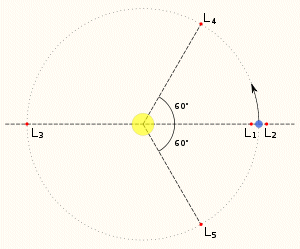|
|
Membership Services General Info Financial Info Activities Awards Coordinators Director's Info Members' Info Policies Forms Publications Official Publications Director's Publications Ask Dr. SETI ® Fiction Non-Fiction Reviews Reading Lists Technical Support Systems Antennas Amplifiers Receivers Accessories Hardware Software Press Relations Fact Sheets Local Contacts Editorials Press Releases Photo Gallery Newsletters Internet Svcs |
|
Do you know of any attempt to look for microwave ET probes that may be at L5/L4 points? I think I might put my system there for a look. I was thinking - If ET were to send Bracewell type probes to its nearby stars they would park them around each planet at its L5 point. They would be low power because they would be powered by sunlight alone, but could have large antennas that unfurl and point at each planet. I think that I would just have to point at a location off the moon by ±60 degrees and track it, but I'm not sure. Do you know where I can come up with the calculation of these points? Jim (Argonaut)
The Doctor Responds: Three-body problems in orbital mechanics are always mathematically challenging, and in many cases intractable. In 1772, Joseph Louis Lagrange figured out an interesting special case. In an orbital system with the proper mass ratio between the primary and secondary objects,* there exist five points where the gravitational attraction of the two bodies upon a third object is in equilibrium. These three points are today called the Lagrangian Points, and are designated L1 through L5. In the case of the Earth and the Sun, for example, they are shown pictorially here:
 There exists a similar set of five Lagrangian Points in the Earth-Moon gravitational system. Likewise, there are similar stable points in systems involving other planets and their moons. So, there are a good many L1, L2, L3, L4, and L5 points in our solar system alone. If an extraterrestrial astronomer can detect a star and its planets, deduce planetary orbits, and estimate stellar and planetary masses, then such a being can compute the existence and location of the resulting Lagrangian Points. Parking an interstellar probe in these gravitationally stable regions is trivial -- at least, to the extent that anything involving interstellar travel can be considered trivial! In the case of Lagrangian Points in a planet-moon orbital system, it gets a little more challenging, because our hypothesized extraterrestrial astronomer has to detect, and analyze the orbits of, moons around exoplanets. I'm not ruling this out, just pointing out the difficulties. To date, a few searches for gravitationally stable interstellar probes have indeed concentrated on Lagrangian Points in the Earth-Sun system. It is reasoned that a civilization detecting the Earth will know that it is in its star's habitable zone (just as we know this about a few of the exoplanets we have detected from Earth). If you want to search for probes in the Earth-Sun L4 and L5 points, all you need to do is point your antenna in the ecliptic (the plane of the Earth's orbit around the Sun), at points in space leading and lagging the Earth by 60 degrees. In other words, look in space where the Earth was two months ago, and where it will be two months hence. Who knows? You might get lucky!
* Specifically, the ratio of the masses of the primary and the secondary objects must exceed 24.96, for stable Lagrangian points to exist.
|
